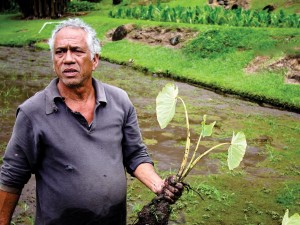He hanana kuikawā ko Kamehameha Maui i kēlā me kēia makahiki kula, nona ka inoa ʻo Poʻalima ʻUlaʻula. He lā ia e kia piha ai ke kula holoʻokoʻa ma ka hoʻoikaika mauli Hawaiʻi.
Wahi a Ekela Kaniaupio-Crozier, he kumu aʻo Haʻawina Hawaiʻi ma Kamehameha Maui, “ʻO ka Poʻalima ʻUlaʻula, ua hoʻokumu ʻia, ua noʻonoʻo ʻia he maikaʻi no kā mākou poʻe haumāna e ʻike ai i ko lākou pono, a me ko lākou kuleana. ʻO ka ʻulaʻula, ke kala o ke koko. ʻO ia ka mea hoʻopili iā kākou a pau. No leila, ʻaʻole lawa paha ke koko. Pono ka ʻike kekahi.”
A na wai e ʻole ke akamai i waiho noʻeau ʻia e nā kūpuna ma o nā mele ʻai pōhaku, e laʻa hoʻi me ke mele, ʻo “Kaulana Nā Pua”.
“ʻO nā mele, he mea e hoʻokaʻa ai i ka ʻike.” i ʻōlelo ai ʻo Ekela.
Eia hou, ʻaʻole nō i pau ka ʻike i ka hālau hoʻokahi. No laila i hele nui mai ai kekahi mau kumu hoʻohālike Hawaiʻi e kaʻana aku ai i ko lākou manaʻo no ia mele me nā haumāna pae kula haʻahaʻa, kula waena, a kula kiʻekiʻe.
“No laila, ka hiki ʻana mai o nā kānaka like ʻole mai kēlā makau, kēia makau, kēlā hana, kēia hana, ʻo ia ka nani. Hōʻike ʻia nā ʻano kuanaʻike like ʻole. Akā, e ʻike ana nō ke keiki, ʻo ka mea e like ai, ʻo ia ke aloha i ka ʻāina, ʻo ia ke kūpaʻa ma hope o ke aliʻi. ʻO ia ka hoʻi ʻana i ka haʻaheo, i ia mea ʻo ka Hawaiʻi… ʻO kekahi kanaka waha ʻōlelo, a me kekahi he kumu hula. No laila, kū mai ke kanaka waha ʻōlelo, walaʻau, kamaʻīlio me nā kamaliʻi, no kekahi manaʻo o kekahi paukū o ke mele ʻai pōhaku. Ma hape, kū mai ke kumu hula, nāna e aʻo.” i ʻōlelo aku ai ʻo Kamuela Yim, he kanaka mahiʻai no Kākoʻo ʻŌiwi.
A paʻa kēia ʻike, ua kīpapa ʻia akula nō he pae hou o ko nā haumāna kahua mauli Hawaiʻi ponoʻī iho nō.
Wahi a Owen Tau-a, he haumāna papa ʻumikūmālua ma Kamehameha Maui, “He mea [ia] e ulu ai koʻu hoi no koʻu moʻomeheu. He hoʻoikaika ma ka hana a hoʻoili maoli ʻana i ke ʻano e Hawaiʻi ai mākou.”
Wahi a Ekela, “Nānā au i kēia poʻe keiki, a ʻaʻole like me ka hoʻomaka ʻana o ka papa. ʻOkoʻa ko lākou ʻano. Piliwi lākou; he kanaka maoli nō, a he kuleana koʻu. A, he waiwai koʻu, a he waiwai koʻu ʻāina, me koʻu poʻe kūpuna. No laila, pono au e kūpaʻa, pono au e kū no koʻu poʻe kānaka.”
[/spb_tab] [spb_tab title=”English”]Each school year, Kamehameha Schools Maui Campus holds Red Friday, a day dedicated to increasing awareness of kuleana for Kānaka Maoli.
“We want our students to gain a sense of place and responsibility as Hawaiians. The ‘red’ symbolizes our Hawaiian blood that unifies all of our students. But, we know that being Hawaiian is not enough, we need to also know what it means.” says Ekela Kaniaupio-Crozier, the Hawaiian Protocol Facilitator at Kamehameha Schools Maui Campus.
And what better way to learn than through our Hawaiian patriotic songs, like “Kaulana Nā Pua”.
Kaniaupio-Crozier says that “Songs are a tool in which our cultural knowledge is passed on.”
As a means to broaden the students’ horizon, community leaders came together to share their interpretation and thoughts on the song.
“It’s great to have people who work in different environments and perspectives. The students will see that we all share the love for our place, and take pride in being Hawaiian. One of us will share our thoughts about a verse with the students, then another will teach the hula for that verse.” says Kamuela Yim, a farmer at Kākoʻo ʻŌiwi.
Once all is said and done, the students gain a deeper understanding of themselves as Hawaiians.
“I think it’s just giving us more of a sense of pride in being Hawaiian. It’s more like, yea we are Hawaiians, but then how much of us actually practice being a Hawaiian. It’s perpetuating us to be, or learn more as a Hawaiian in a Hawaiian aspect.” says Owen Tau-a, a Senior at Kamehameha Schools Maui.
Kaniaupio-Crozier says that, “I look at these students, and see that they learned something. They are inspired and have a firm understanding of who they are, and their responsibility to value and care for our Hawaiʻi.”
[/spb_tab] [/spb_tabs]



